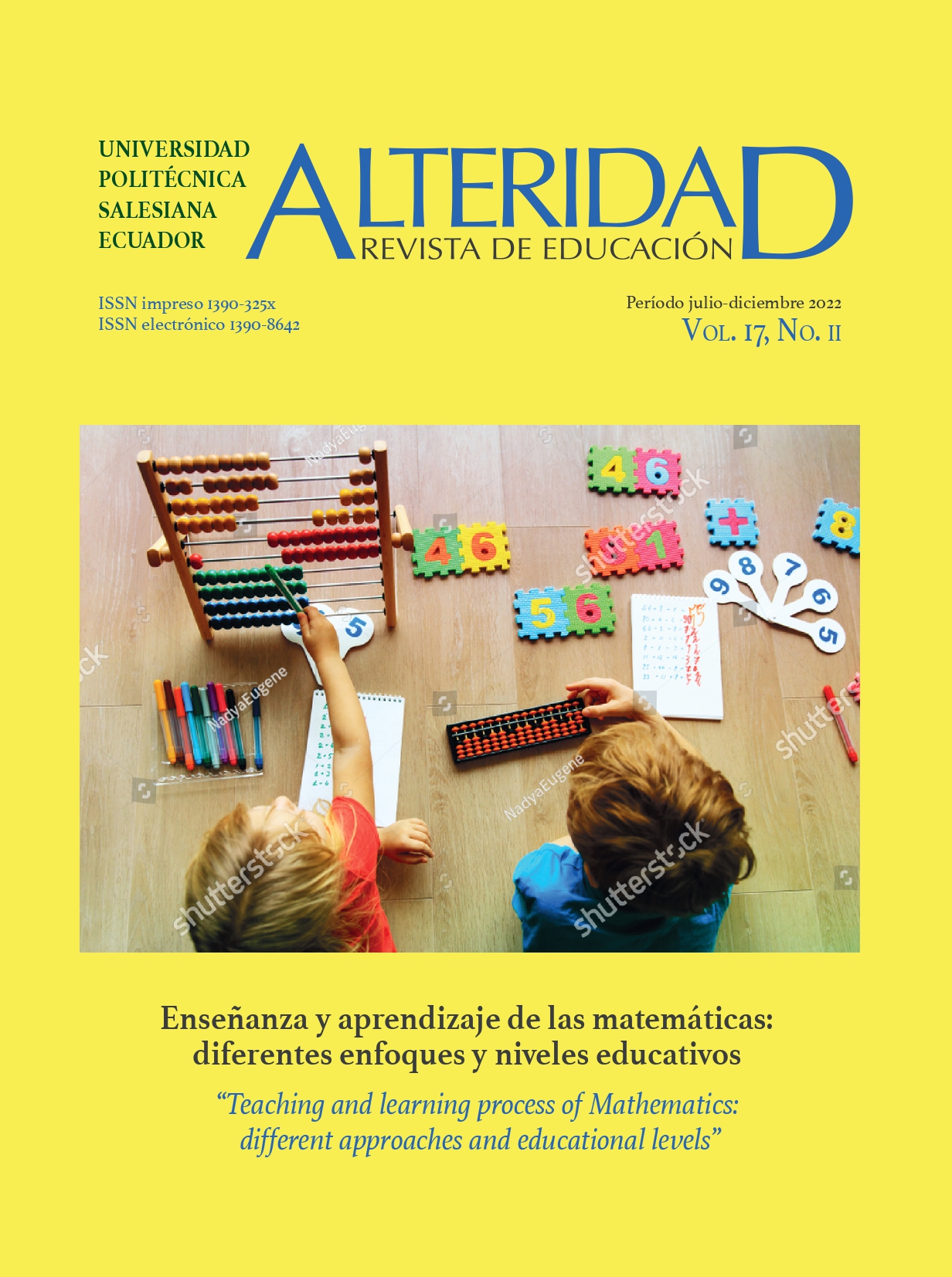Influencia del contexto de enseñanza en la representación de patrones en educación infantil
Contenido principal del artículo
Resumen
Detalles del artículo

Esta obra está bajo una licencia internacional Creative Commons Atribución-NoComercial-CompartirIgual 4.0.
Autoría: En la lista de autores firmantes deben figurar únicamente aquellas personas que han contribuido intelectualmente al desarrollo del trabajo. Haber colaborado en la recolección de datos no es, por sí mismo, criterio suficiente de autoría. “Alteridad” declina cualquier responsabilidad sobre posibles conflictos derivados de la autoría de los trabajos que se publiquen.
Copyright: La Universidad Politécnica Salesiana conserva los derechos patrimoniales (copyright) de los artículos publicados, y favorece y permite la reutilización de las mismas bajo la licencia Creative Commons Atribución-NoComercial-CompartirIgual 3.0 Ecuador. Se pueden copiar, usar, difundir, transmitir y exponer públicamente, siempre que: i) se cite la autoría y la fuente original de su publicación (revista, editorial y URL de la obra); ii) no se usen para fines comerciales; iii) se mencione la existencia y especificaciones de esta licencia de uso.
Referencias
Bock, A.M., Cartwright, K.B., McKnight, P.E., Patterson, A.B., Shriver, A.G., Leaf, B.M., Mohtasham, M.K., Vennergrund, K.C., y Pasnak, R. (2018). Patterning, Reading, and Executive Functions. Frontiers in Psychology, 9, 1802.
Björklund, C., y Pramling, N. (2014). Pattern discernment and pseudo-conceptual development in early childhood mathematics education. International Journal of Early Years Education, 22 (1), 9-104. http://10.1080/09669760.2013.809657
Björklund, C., van den Heuvel-Panhuizen, M., y Kullberg, A. (2020). Research on early childhood mathematics teaching and learning. ZDM Mathematics Education. https://doi.org/10.1007/s11858-020-01177-3
Bowman, B., Donovan, M., y Burns, M. (2001). Eager to learn: Educating our preschoolers. National Academy Press.
Carruthers, E., y Worthington, M. (2005) Making Sense of Mathematical Graphics: The Development of Understanding Abstract Symbolism. European Early Childhood Educational Research Journal, 13(1), 57-79.
Clements, H.D., y Sarama, J. (2015). El Aprendizaje y la Enseñanza de las Matemáticas a Temprana Edad. Learning Tools LLC.
Creswell, J.W., y Plano Clark, V.L. (2011). Designing and Conducting Mixed Methods Research. 2nd Edition, Sage Publications.
Freudenthal, H. (1991). Revisiting mathematics education. Kluwer Academic Publishers.
Kawulich, B.B. (2005). La observación participante como método de recolección de datos. Forum Qualitative Social Research, 6(2).
Korthagen, F. A. (2001). Linking practice and theory. The pedagogy of realistic teacher education. Lawrence Erlbaum Associates.
Laski, E. V., y Siegler, R. S. (2014). Learning from number board games: You learn what you encode. Developmental Psychology, 50(3), 853-864.
Leeuwen, V.T. (2008). Discourse and practice: New tools forcritical discourse analysis. Oxford University Press.
Lüken, M. (2018). Is patterning a mathematical activity?—An analysis of young children’s strategies in working with repeating patterns. In A mathematics education perspective on early mathematics learning—POEM. https://doi.org/10.1007/978-3-030-34776-5_5
Mitchelmore, S. (2018). Providing Insight Through Pedagogical Documentation: Seeing Research as an Everyday Practice. En M. Fleer, y B. van Oers (Eds.), International Handbook of Early Childhood Education Volume I (pp.190-195). Springer.
Mulligan, J. T., y Mitchelmore, M. C. (2009). Awareness of pattern and structure in early mathematical development. Mathematics Education Research Journal, 21(2), 33–49.
Mulligan, J.T., Oslington, G., y English, L. D. (2020) Supporting early mathematical development through a 'pattern and structure' intervention program. ZDM—International Journal of Mathematics Education, 52, 663-676. https://doi.org/10.1007/s11858-020-01147-9
National Council of Teachers of Mathematics [NCTM]. (2000). Principles and standards for school mathematics. The National Council of Teachers of Mathematics.
NCTM. (2014). Principles to actions: Ensuring mathematical success for all. National Council of Teachers of Mathematics, Inc.
Nguyen, T., Watts, T. W., Duncan, G. J., Clements, D., Sarama, J., Wolfe, C., y Spitler, M. E. (2016). Which preschool mathematics competencies are most predictive of fifth grade achievement? Early Childhood Research Quarterly, 36, 550– 560. https://doi.org/10.1016/j.ecresq.2016.02.003
Papic, M.M. (2015). An Early Mathematical Patterning Assessment: identifying young Australian Indigenous children’s patterning skills. Mathematics Education Research Journal, 27(4), 519-534. https://doi.org/10.1007/s13394-015-0149-8
Papic, M. M., Mulligan, J. T., y Mitchelmore, M. C. (2011). Assessing the development of pre-schoolers' mathematical patterning. Journal for Research in Mathematics Education, 42, 237-268.
Pino-Fan, L., Guzmán, I., Font, V., y Duval, R. (2017). Analysis of the underlying cognitive activity in the resolution of a task on derivability of the absolute-value function: Two theoretical perspectives. PNA, 11(2), 97-124.
Radford, L., y Sabena, C. (2015). The question of method in a Vygotskyan semiotic approach. En A. Bikner-Ahsbahs, C. Knipping, y N. Presmeg (Eds.), Approaches to qualitative research in mathematics education: Examples of methodology and methods (pp. 157–182). Springer. https://doi.org/10.1007/978-94-017-9181-6_7
Rittle-Johnson, B., Fyfe, E. R., Hofer, K. G., y Farran, D. C. (2017). Early math trajectories: Low-income children’s mathematics knowledge from age 4 to 11. Child Development, 88, 1727– 1742. https://doi.org/10.1111/cdev.12662
Rittle-Johnson, B, Zippert, E. L., y Boice, K. L. (2018). The Roles of Patterning and Spatial Skills in Early Mathematics Development. Early Childhood Research Quarterly, 46, 166-178.
Sibgatullin, I. R., Korzhuev, A. V., Khairullina, E. R., Sadykova, A. R., Baturina, R. V., y Chauzova, V. (2022). A Systematic Review on Algebraic Thinking in Education. Eurasia Journal of Mathematics, Science and Technology Education, 18(1), em2065. https://doi.org/10.29333/ejmste/11486
Tirosh, D., Tsamir, P., Barkai, R., y Levenson, E. (2018). Engaging young children with mathematical activities involving different representations: Triangles, patterns, and counting objects. CEPS Journal, 8(2), 9-30.
Vanluydt, E., Wijns, N., Torbeyns, J., y Dooren, W.V. (2021). Early childhood mathematical development: the association between patterning and proportional reasoning. Educational Studies in Mathematics 107, 93–110. https://doi.org/10.1007/s10649-020-10017-w
Vygotsky, L.S. (1978). Mind in society. The development of higher psychological processes. Harward University Press.
Wijns, N., Torbeyns, J., Bakker, M., De Smedt B., y Verschaffel, L. (2019). Four-year olds' understanding of repeating and growing patterns and its association with early numerical ability. Early Childhood Research Quarterly, 49, 152-163.
Wijns, N., Verschaffel, L., De Smedt, B., y Torbeyns, J. (2021). Associations between repeating patterning, growing patterning, and numerical ability: A longitudinal panel study in four- to six-year olds. Child Development, 92, 1354-1368. https://doi.org/10.1111/cdev.13490
Autores (XXXX)
Autores (XXXX)
Autores (XXXX)
Autores (XXXX)
Autores (XXXX)
Autores (XXXX)

